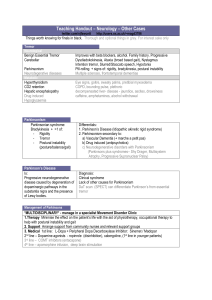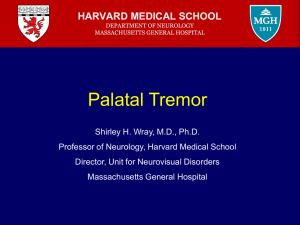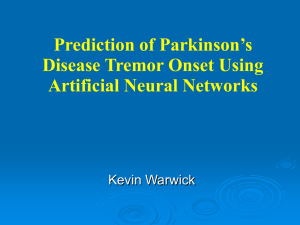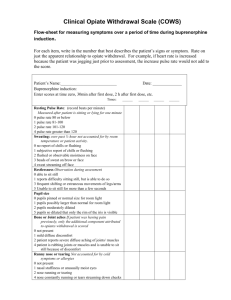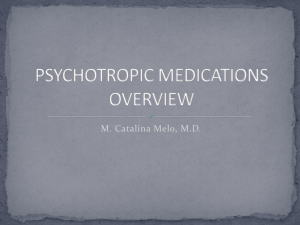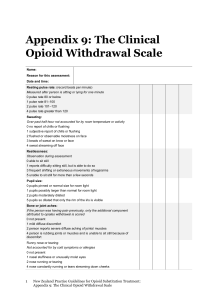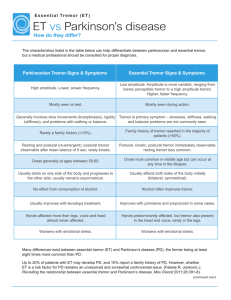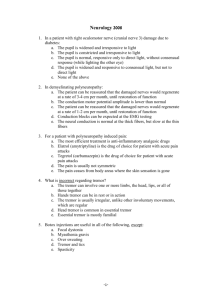Surgery for Tremor
advertisement
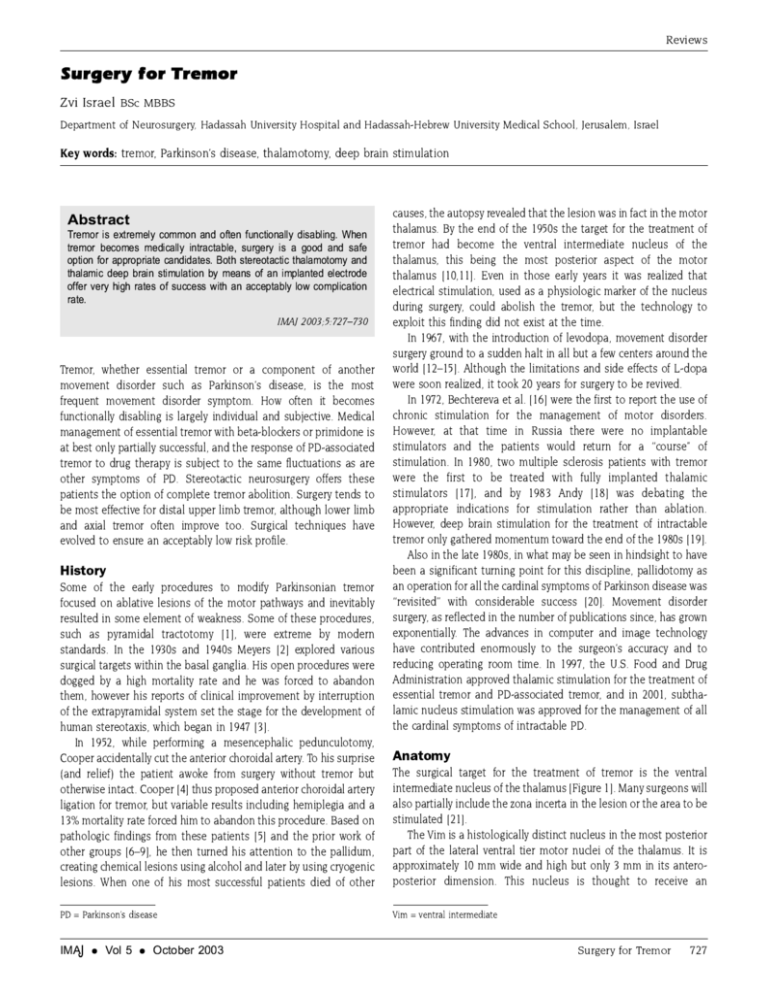
Reviews Surgery for Tremor Zvi Israel BSc MBBS Department of Neurosurgery, Hadassah University Hospital and Hadassah-Hebrew University Medical School, Jerusalem, Israel Key words: tremor, Parkinson's disease, thalamotomy, deep brain stimulation Abstract Tremor is extremely common and often functionally disabling. When tremor becomes medically intractable, surgery is a good and safe option for appropriate candidates. Both stereotactic thalamotomy and thalamic deep brain stimulation by means of an implanted electrode offer very high rates of success with an acceptably low complication rate. IMAJ 2003;5:727±730 Tremor, whether essential tremor or a component of another movement disorder such as Parkinson's disease, is the most frequent movement disorder symptom. How often it becomes functionally disabling is largely individual and subjective. Medical management of essential tremor with beta-blockers or primidone is at best only partially successful, and the response of PD-associated tremor to drug therapy is subject to the same fluctuations as are other symptoms of PD. Stereotactic neurosurgery offers these patients the option of complete tremor abolition. Surgery tends to be most effective for distal upper limb tremor, although lower limb and axial tremor often improve too. Surgical techniques have evolved to ensure an acceptably low risk profile. History Some of the early procedures to modify Parkinsonian tremor focused on ablative lesions of the motor pathways and inevitably resulted in some element of weakness. Some of these procedures, such as pyramidal tractotomy [1], were extreme by modern standards. In the 1930s and 1940s Meyers [2] explored various surgical targets within the basal ganglia. His open procedures were dogged by a high mortality rate and he was forced to abandon them, however his reports of clinical improvement by interruption of the extrapyramidal system set the stage for the development of human stereotaxis, which began in 1947 [3]. In 1952, while performing a mesencephalic pedunculotomy, Cooper accidentally cut the anterior choroidal artery. To his surprise (and relief) the patient awoke from surgery without tremor but otherwise intact. Cooper [4] thus proposed anterior choroidal artery ligation for tremor, but variable results including hemiplegia and a 13% mortality rate forced him to abandon this procedure. Based on pathologic findings from these patients [5] and the prior work of other groups [6±9], he then turned his attention to the pallidum, creating chemical lesions using alcohol and later by using cryogenic lesions. When one of his most successful patients died of other PD = Parkinson's disease IMA J . Vol 5 . October 2003 causes, the autopsy revealed that the lesion was in fact in the motor thalamus. By the end of the 1950s the target for the treatment of tremor had become the ventral intermediate nucleus of the thalamus, this being the most posterior aspect of the motor thalamus [10,11]. Even in those early years it was realized that electrical stimulation, used as a physiologic marker of the nucleus during surgery, could abolish the tremor, but the technology to exploit this finding did not exist at the time. In 1967, with the introduction of levodopa, movement disorder surgery ground to a sudden halt in all but a few centers around the world [12±15]. Although the limitations and side effects of L-dopa were soon realized, it took 20 years for surgery to be revived. In 1972, Bechtereva et al. [16] were the first to report the use of chronic stimulation for the management of motor disorders. However, at that time in Russia there were no implantable stimulators and the patients would return for a ` course'' of stimulation. In 1980, two multiple sclerosis patients with tremor were the first to be treated with fully implanted thalamic stimulators [17], and by 1983 Andy [18] was debating the appropriate indications for stimulation rather than ablation. However, deep brain stimulation for the treatment of intractable tremor only gathered momentum toward the end of the 1980s [19]. Also in the late 1980s, in what may be seen in hindsight to have been a significant turning point for this discipline, pallidotomy as an operation for all the cardinal symptoms of Parkinson disease was ` revisited'' with considerable success [20]. Movement disorder surgery, as reflected in the number of publications since, has grown exponentially. The advances in computer and image technology have contributed enormously to the surgeon's accuracy and to reducing operating room time. In 1997, the U.S. Food and Drug Administration approved thalamic stimulation for the treatment of essential tremor and PD-associated tremor, and in 2001, subthalamic nucleus stimulation was approved for the management of all the cardinal symptoms of intractable PD. Anatomy The surgical target for the treatment of tremor is the ventral intermediate nucleus of the thalamus [Figure 1]. Many surgeons will also partially include the zona incerta in the lesion or the area to be stimulated [21]. The Vim is a histologically distinct nucleus in the most posterior part of the lateral ventral tier motor nuclei of the thalamus. It is approximately 10 mm wide and high but only 3 mm in its anteroposterior dimension. This nucleus is thought to receive an Vim = ventral intermediate Surgery for Tremor 727 Reviews excitatory cerebellar input and to project to the motor cortex (areas 4 and 6). The zona incerta contains within it the thalamic fasciculus (or field H1 of Forel), partly made up of dentatothalamic and pallidothalamic fiber tracts. Most targets for functional neurosurgery are referenced to the position of an imaginary line spanning the third ventricle, joining the anterior commissure and the posterior commissure. According to Guiot [22] the Vim will be located in the AC-PC plane, 11 mm lateral to the wall of the third ventricle (13±15 mm lateral to the midline) and one quarter of the AC-PC distance anterior to the PC. The surgeon uses these landmarks and these coordinates to direct the electrode to the nucleus. Indications Most experience has been accrued in patients with essential tremor and tremor-dominant PD; however, post-traumatic tremor and tremor associated with multiple sclerosis will also usually respond well to thalamic surgery especially if there is a significant intention tremor element. The tremor should have become resistant to medical therapy and should be functionally and/or socially disabling. Patients must be cooperative, as surgery is performed with the patient awake. Hypertension must be well controlled. Aspirin and other anticoagulants must be stopped well enough in advance of surgery to ensure a normal coagulation profile. Patients are evaluated preoperatively with a quality of life questionnaire and their tremor score is calculated. A video recording is made of the patient at rest and during activity, and at different stages of the drug cycle. Figure 1. Coronal section through the thalamus. The target is at the base of the Vim nucleus, at the AC-PC plane, approximately 11 mm from the lateral wall of the third ventricle. The proximity to the internal capsule laterally and the subthalamic nucleus inferiorly is demonstrated. Methods The method used is identical to that described by Burchiel [23]. Anti-tremor medication is withheld on the day of surgery so that the tremor is not suppressed in the awake patient during surgery. Neurosurgery for movement disorders requires the placement of a stereotactic frame under local anesthetic. Together with subsequent imaging (magnetic resonance imaging or computerized tomography) the external frame acts as a fixed landmark allowing precise navigation to specific intracranial targets. Figure 2 shows the Radionics CRW frame affixed to the patient's head. The MR and/ or CT images acquired are transferred over the hospital network to a computerized workstation. Using specific software (Framelink, Medtronic SNT, Louisville, CO, USA), the stereotactic frame and anatomic landmarks of the brain can be registered in virtual space and thus the target (Vim) coordinates are calculated [Figure 3]. In the operating room, the rest of the stereotactic system is set up to reflect the calculated coordinates of the target. Under local anesthetic, a small twist-drill hole is made in the skull and the radiofrequency electrode is introduced and advanced to the target. Occasionally the mere mechanical effect of introducing the electrode will temporarily abolish the tremor ± the so-called AC = anterior commissure PC = posterior commissure 728 Z. Israel Figure 2. The patient is awaiting MR scanning with the stereotactic frame and image localizer affixed to her head. Figure 3. Planning of the target using Framelink software. The axial image shows the anterior and posterior commissures and the calculated target for the right Vim. IMA J . Vol 5 . October 2003 Reviews microthalamotomy effect. Electrical stimulation allows evaluation of proximity to the internal capsule laterally and the sensory thalamus posteriorly. High frequency stimulation should abolish the tremor. Once location has been verified, three radiofrequency lesions are made at 70 degrees for 60 seconds while testing for pyramidal motor function and speech. The entire procedure uses between 30 and 40 minutes of operating room time. The patient is discharged the following day. If deep brain stimulation is to be utilized the procedure is identical; however, rather than ablate the Vim, a four-contact electrode is implanted and secured in position to the skull. General anesthetic is induced and the permanent impulse generator is implanted subcutaneously, usually in the infraclavicular region, much like a cardiac pacemaker. This latter procedure utilizes approximately 2.5 hours of operating room time and the patient may be discharged the following day after the generator is programmed. functionally significant [26]. Bilateral thalamotomy, however, is associated with a significantly higher incidence of significant complications and is therefore avoided. Discussion Immediate abolition or improvement of the tremor (defined as more than 50% tremor reduction) is the norm in up to 95% of patients [24]. This benefit is usually long lasting [25]. Parkinsonian patients may require less or no L-dopa therapy after surgery [26,27]. Axial tremor (head, voice) partially subsides with unilateral surgery and more significantly with bilateral surgery [28]. In a minority of patients there may be partial tremor recurrence. Short-term recurrence in patients who have undergone thalamotomy is usually evident within 1 month and can be resolved by reoperation. Longer term recurrence may be due to disease progression, and re-operation (to increase the size of the lesion) or higher amplitude stimulation may be necessary. In patients treated with DBS, late tremor recurrence may be due to tolerance. This can usually be managed by a ` stimulation holiday'' of several weeks or occasionally by thalamotomy. Complications fall into two categories: those considered as general risks of stereotactic surgery and those related to neural injury (thalamotomy) or hardware failures (DBS). General risks include infection and hemorrhage, but these are rare (less than 1%). Hemorrhage is the only significant cause of mortality in stereotactic procedures (0.3%), and the incidence is drastically reduced by controlling hypertension, stopping anticoagulant medication well in advance of the surgery, and careful planning of the surgical trajectory to avoid cortical or deep vasculature. Modern neuroimaging and computerized targeting allow for greater accuracy and, thus, the luxury of making smaller lesions. This is reflected in the lower incidence of transient or permanent neurologic deficits in modern series, although there is probably an increased chance of tremor recurrence. The most common transient deficits are hemiparesis, dysarthria, ataxia, and sensory deficits [26,29]. These generally improve as edema surrounding the lesion resolves over a period of several weeks. Permanent neurologic deficit following thalamotomy is unusual [25] and is rarely Several controversial issues are worth mention. The first concerns the role of microelectrode recording during the procedure [30]. MER aims to record the extracellular electrical activity of single cells in the target nucleus by means of introducing a high impedance electrode with a tip size of 15-40 m. The identification of recognized discharge patterns, such as those seen with ` tremor'' cells, can help confirm that the target is indeed within the desired location. MER has both its proponents and its detractors. Those against the procedure believe that it may increase the risk of hemorrhage, that micron accuracy is unnecessary if a multimillimeter lesion is to be made, and that it significantly increases operating time, which may be hard on an awake patient. Those in favor of MER maintain the necessity for exquisite physiologic validation [31], stress the limitations of ` macroelectrode'' mapping, and claim that the complication rate is a function of the experience of the practitioner [32]. However, no randomized prospective study has been performed to compare outcome with and without the utility of MER. Two recent metaanalyses showed no advantage of using MER for targeting either Gpi [33] or Vim [24]. The entire debate is beyond the scope of this manuscript, but it should be pointed out that the Vim has been successfully targeted both with [31] and without [34] the use of MER. A second controversy concerns the relative benefits and risks of thalamotomy compared to thalamic DBS. Unilateral tremor may be treated adequately and effectively by either modality. While bilateral thalamotomy is no longer advocated because of the increased risk of complications, bilateral tremor may be treated by sequential thalamotomy and contralateral DBS [35] or by bilateral DBS. A few studies have compared thalamotomy to thalamic DBS [36±39]. These inevitably show equivalent efficacy of both procedures, but a lower complication rate for DBS. The most oft-quoted study, however, is flawed inasmuch as the thalamotomy lesion is rather large by modern standards [38]. Thalamotomy offers the advantages of a single short hospital admission and no implanted technology, however the effects of the thermal lesion are irreversible. DBS due to its reversibility is thought to be safer. DBS also offers the patient an element of control over the system by means of an external magnet. However, DBS has disadvantages too. The generator occasionally demands lengthy fine-tuning and either multiple admissions or outpatient visits. Implanted hardware is inevitably associated with an increased rate of infection. Tachyphylaxis and the necessity for battery replacement are other significant issues. Finally, the cost of DBS hardware is considerable, although the cost of bilateral stimulation has been somewhat reduced by the introduction of a dual channel stimulator. A third issue to be mentioned is the effect that reducing or DBS = deep brain stimulation MER = microelectrode recording Results IMA J . Vol 5 . October 2003 Surgery for Tremor 729 Reviews abolishing tremor has on the quality of life [40]. While for patients with essential tremor or other forms of postural and action tremor the benefit of surgery is clear [40], the tremor in Parkinson's disease is usually a resting tremor. Thus, the functional benefit of resolving tremor in PD patients is debatable. Most would agree that if tremor is the sole or dominant symptom of PD then surgery should be considered. However, for many PD patients who are medically intractable, an alternative target should be considered, such as the GPi or subthalamic nucleus stimulation, especially if there are other symptoms of PD or complications of medication such as dyskinesias. In these patients, subthalamic nucleus stimulation has been as effective as thalamic stimulation in the control of tremor. References 1. Oliver L. Surgery in Parkinson's disease. Division of lateral pyramidal tract for tremor. Report on 48 patients. Lancet 1949;i:910±13. 2. Meyers R. The modification of alternating tremors, rigidity and festination by surgery of the basal ganglia. Res Publ Assoc Res Nerv Ment Dis 1942;21:602±65. 3. Spiegel E, Wycis H, Marks M, et al. Stereotaxic apparatus for operations on the human brain. Science 1947;106:349±50. 4. Cooper I. Ligation of the anterior choroidal artery for involuntary movements of Parkinsonism. Psychiatr Q 1953;27:317±19. 5. Rand R, Brown W, Stern W. Surgical occlusion of anterior choroidal arteries in Parkinsonism. Clinical and neuropathologic findings. Neurology 1956;6:390±401. 6. Guiot G, Brion S. Traitement des mouvements anormaux par la coagulation pallidale: Technique et resultats. Rev Neurol 1953;89:578±80. 7. Narabayashi H, Okuma T. Procaine oil blocking of the globus pallidus for the treatment of rigidity and tremor of Parkinsonism. Proc Jpn Acad 1953;29:134±7. 8. Riechert T, Wolff M. Die technische Durchfuhrung von gezielten Hirnoperationen. Arch Psychiatr Z Neurol 1953;190:297±316. 9. Spiegel E, Wycis H. Ansotomy in paralysis agitans. Arch Neurol 1954;71:598±614. 10. Cooper I, Bravo G, Riklan M, et al. Chemopallidectomy and chemothalamectomy for parkinsonism. Geriatrics 1958;13:127±47. 11. Hassler R, Riechert T. Indikationen und Lokalisationmethode der gezielten Hirnoperationen. Nervenarzt 1954;25:441±7. 12. Ohye C, Hirai T, Miyazaki M, et al. Vim thalamotomy for the treatment of various kinds of tremor. Appl Neurophysiol 1982;45(3):275±80. 13. Tasker RR, Siqueira J, Hawrylyshyn P, et al. What happened to VIM thalamotomy for Parkinson's disease? Appl Neurophysiol 1983;46(1-4):68± 83. 14. Narabayashi H, Maeda T, Yokochi F. Long-term follow-up study of nucleus ventralis intermedius and ventrolateralis thalamotomy using a microelectrode technique in parkinsonism. Appl Neurophysiol 1987;50(16):330±7. 15. Wester K, Hauglie-Hanssen E. Stereotaxic thalamotomy ± experiences from the levodopa era. J Neurol Neurosurg Psychiatry 1990;53(5):427±30. 16. Bechtereva N, Bondarchuk A, Smirnov V. Therapeutic stimulations of the deep brain structures. Vopr Neirokhir 1972;1:7±12. 17. Brice J, McLellan L. Suppression of intention tremor by contingent deepbrain stimulation. Lancet 1980;1(8180):1221±2. 18. Andy OJ. Thalamic stimulation for control of movement disorders. Appl Neurophysiol 1983;46(1-4):107±11. 19. Benabid AL, Pollak P, Louveau A, et al. Combined (thalamotomy and stimulation) stereotactic surgery of the VIM thalamic nucleus for bilateral Parkinson disease. Appl Neurophysiol 1987;50(1-6):344±6. 20. Laitinen LV, Bergenheim AT, Hariz MI. Leksell's posteroventral pallidotomy in the treatment of Parkinson's disease. J Neurosurg 1992;76(1):53± 61. 730 Z. Israel 21. Nandi D, Chir M, Liu X, et al. Electrophysiological confirmation of the zona incerta as a target for surgical treatment of disabling involuntary arm movements in multiple sclerosis: use of local field potentials. J Clin Neurosci 2002;9(1):64±8. 22. Benabid AL, Pollak P. Chronic electrical stimulation of the ventralis intermedius nucleus of the thalamus as a treatment of movement disorders. J Neurosurg 1996;84:203±14. 23. Burchiel KJ. Thalamotomy for movement disorders. Neurosurg Clin North Am 1995;6(1):55±71. 24. Slavin KV, Burchiel KJ. Thalamotomy without microelectrode recording. In: Lozano A, ed. Movement Disorder Surgery. Basel: Karger, 2000:172± 80. 25. Pahwa R, Lyons K, Koller WC. Surgical treatment of essential tremor. Neurology 2000;54(11 Suppl 4):S39±44. 26. Hua SE, Garonzik IM, Lee J, et al. Thalamotomy for tremor. In: Lozano A, ed. Surgical Treatment of Parkinson's Disease and Other Movement Disorders. Totowa, NJ: Humana Press Inc., 2003:99±113. 27. Benabid AL, Pollak P, Gao D, et al. Chronic electrical stimulation of the ventralis intermedius nucleus of the thalamus as a treatment of movement disorders. J Neurosurg 1996;84:203±14. 28. Taha JM, Janszen MA, Favre J. Thalamic deep brain stimulation for the treatment of head, voice, and bilateral limb tremor. J Neurosurg 1999;91(1):68±72. 29. Akbostanci MC, Slavin KV, Burchiel KJ. Stereotactic ventral intermedial thalamotomy for the treatment of essential tremor: results of a series of 37 patients. Stereotact Funct Neurosurg 1999;72(2-4):174±7. 30. Israel Z, Hsu F, Burchiel KJ. Is microelectrode recording necessary? Semin Neurosurg 2001;12(2):169±74. 31. Garonzik IM, Hua SE, Ohara S, et al. Intraoperative microelectrode and semi-microelectrode recording during the physiological localization of the thalamic nucleus ventral intermediate. Mov Disord 2002;17(Suppl 3):S135±44. 32. Linhares MN, Tasker RR. Microelectrode-guided thalamotomy for Parkinson's disease. Neurosurgery 2000;46(2):390±5; discussion 395±8. 33. Palur RS, Berk C, Schulzer M, et al. A metaanalysis comparing the results of pallidotomy performed using microelectrode recording or macroelectrode stimulation. J Neurosurg 2002;96(6):1058±62. 34. Valalik I, Sagi S, Solymosi D, et al. CT-guided unilateral thalamotomy with macroelectrode mapping for the treatment of Parkinson's disease. Acta Neurochir (Wien) 2001;143(10):1019±30. 35. Slavin KV, Louw D, Burchiel KJ. Treatment of bilateral tremor with thalamotomy and contralateral thalamic stimulation. J Neurosurg 1999;90:436A. 36. Tasker RR, Munz M, Junn FS, et al. Deep brain stimulation and thalamotomy for tremor compared. Acta Neurochir Suppl (Wien) 1997;68:49±53. 37. Niranjan A, Jawahar A, Kondziolka D, et al. A comparison of surgical approaches for the management of tremor: radiofrequency thalamotomy, gamma knife thalamotomy and thalamic stimulation. Stereotact Funct Neurosurg 1999;72(2-4):178±84. 38. Schuurman PR, Bosch DA, Bossuyt PM, et al. A comparison of continuous thalamic stimulation and thalamotomy for suppression of severe tremor. N Engl J Med 2000;342(7):461±8. 39. Pahwa R, Lyons KE, Wilkinson SB, et al. Comparison of thalamotomy to deep brain stimulation of the thalamus in essential tremor. Mov Disord 2001;16(1):140±3. 40. Lyons KE, Pahwa R, Busenbark KL, et al. Improvements in daily functioning after deep brain stimulation of the thalamus for intractable tremor. Mov Disord 1998;13(4):690±2. Dr. Z. Israel, Dept. of Neurosurgery, Hadassah University Hospital, P.O. Box 12000, Jerusalem 91120, Israel. Phone: (972-2) 677-7094 Fax: (972-2) 64-49302 email. israelz@hadassah.org.il Correspondence: IMA J . Vol 5 . October 2003

